What is Pigmentation?
When a section of your skin has a different colour than the surrounding skin, it’s called pigmentation.
This section of the skin can be in a patch or a spot form.
Pigment means colour, and since this section of skin is different in appearance due to its colour, its occurrence is called pigmentation.
What are the Types of Pigmentation?
There are 2 types of pigmentation:
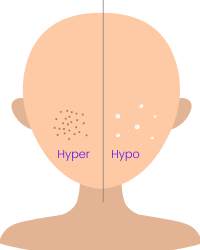
Biologically, What Exactly is Pigmentation?
Melanin is a molecule that gives the skin its colour.
People with darker skin tones produce more melanin than people with lighter skin tones.
Sometimes, a section of a person’s skin can have a different amount of melanin than another.
When a section of the skin has more melanin than the surrounding skin, it is called hyperpigmentation.
This section will be darker than the surrounding skin, which could be a dark spot or patch.
Hyper means more, and pigment means colour. Hence, hyperpigmentation means more colour in that section of the skin.
Hypopigmentation usually occurs when the melanin-producing cells are either burned or damaged to the extent that the skin in that section either has no melanin or very little melanin.
Melanin is responsible for giving skin its natural colour, so when no melanin or less melanin is present, the affected area appears lighter than the surrounding skin. This results in a patch of skin that is paler than the rest.
Hypo means less than normal, and pigment means colour. Hence, hypopigmentation means less colour in that section of the skin.
Key points in this section:
Hyperpigmentation and hypopigmentation are both caused when a section of the skin has a different amount of melanin than the rest of the skin—more in the case of hyperpigmentation and less in the case of hypopigmentation.
Hyperpigmentation occurs when the pigmentation appears darker than the rest of the skin, while hypopigmentation occurs when it appears lighter.
More about Melanin
Melanin has 2 essential functions:
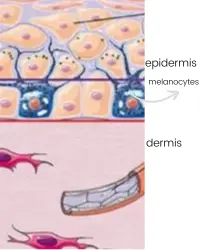
Where is this melanin coming from?
The skin has two main layers: the epidermis (the top layer) and the dermis (the bottom layer). As shown in blue in the picture, a few melanocyte cells exist between these two layers.
Melanin is produced inside these melanocyte cells. Once produced, it is placed into tiny organelles called melanosomes.
Think of melanosomes as a box and melanin as the gift inside this box 🙂
These melanosomes that contain melanin are then transferred from melanocyte cells to keratinocyte cells.
Keratinocytes are the most abundant cell type in the epidermis, and melanin needs to be present in these cells to protect the skin. Therefore, melanin is transferred from melanocyte cells to keratinocyte cells.
Key points in this section:
After melanin is produced by melanocytes, it is packaged into melanosomes and transferred to keratinocytes where it provides protection to the skin.
Causes for Hyperpigmentation & Hypopigmentation
The following are the 5 main causes for both these types of pigmentation:
The article focuses on the first two causes of skin pigmentation: the sun’s UV rays and skin trauma from breakouts & allergens. These causes can be addressed largely by using off-the-shelf skincare ingredients. The other three causes require medical assistance.
When any of the above 5 reasons results in an overproduction of melanin, it produces hyperpigmentation.
Hypopigmentation occurs when any of the above 5 reasons damages melanin-producing cells, resulting in reduced or zero melanin content.
The 2 Common Causes of Pigmentation
Out of the 5 causes mentioned above, the top 2 are the most common causes of pigmentation:
Does Pigmentation Affect Everyone Equally?
No! Genetics has a significant impact on pigmentation.
Although everyone is affected by UV rays, allergens, and breakouts, the intensity of their pigmentation is determined by their genes.
Let me explain this in more detail…
Melanocytes are the cells responsible for producing melanin, the pigment that gives skin its colour. All humans typically have the same number of melanocytes, but the amount of melanin produced in these cells varies. The darker your skin tone, the more melanin you produce. And the more melanin you produce, the more you pigment.
How different skin tones react to the Sun’s UV rays:
Skin phototyping is the process of classifying skin based on how it responds to the sun’s exposure, specifically how it tans and burns.
The Fitzpatrick classification method is the most widely accepted method of skin phototyping, which divides skin types into six categories, ranging from very fair to dark brown. The first category, phototype 1, is very fair, while the second category, phototype 2, is fair, and so on until we reach phototype 6.
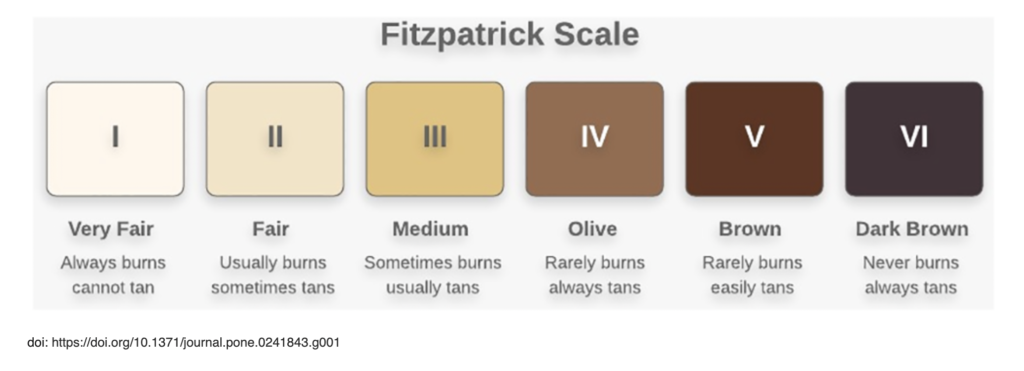
As soon as the sun’s UV rays hit our skin, our skin starts producing melanin, leading to tanned skin. The colour of a tan is from the colour of melanin.
Notice how, on the above scale, people with darker skin tones tend to tan more than those with lighter skin tones. This is because darker skin tones are more able to produce additional melanin.
Conversely, people with lighter skin tones can produce less melanin, making them more susceptible to sunburn.
Listed below are 4 important facts about pigmentation:
Key points in this section:
The darker your skin tone, the more your hyperpigmentation (a section of skin darker than the rest).
The darker your skin tone, you hypopigment less (a section of skin paler than the rest), but your hypopigmentation is often more visible than other skin types because of the contrasting colours.
On the other hand, the darker your skin tone, the more protection you get from the sun’s UV rays.
Melanin alone is not enough to protect the skin from damage. Regular use of sunscreen is necessary to prevent premature aging, pigmentation, and skin cancer regardless of skin tone.
Pigmentation from Inflammation
This post only covers how to reduce or prevent inflammation using off-the-shelf skincare products. It does not address inflammation caused by severe skin trauma. For serious injuries, consult a doctor.
The inflammation we are talking about in this post is from:
This might look like a small list, but these are the most common causes and result in most of the pigmentation we experience.
Going a bit deeper into the skin to understand this better…
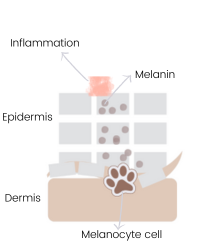
When the skin becomes inflammed, melanocyte cells begin producing melanin to aid in its healing. This is the natural healing mechanism of the skin.
Notice how, in the image, when skin is inflammed, melanocyte cells start producing melanin and distribute that melanin to the cells in the top layer.
It is important to remember that sometimes this inflammation is visible, and sometimes not. But it always occurs when the skin is exposed to irritants.
Melanin production and its distribution to protect our skin sound helpful, but this process is not as smooth sailing as it sounds…Here is why:
In individuals with darker skin tones, melanocyte cells produce excessive melanin. Excess melanin does not necessarily mean faster or better healing.
Think of it this way: A 2-litre bucket can only hold 2 litres of water. Because of a water shortage, we can’t fill the bucket with 5 litres of water from the river and bring it back home. There is a maximum limit. Water will overflow. The additional water is excess.
Similarly, after a certain quantity, melanin becomes excess.
Caution:
Excess melanin does not mean the skin has received 100% protection from irritants. There is a maximum level of protection melanin can provide. After that level has reached, the additional melanin becomes excess.
But melanocyte cells don’t know this. When there is inflammation, they respond. They continue to produce melanin as long as there is inflammation and as long as possible.
Pigmentation in darker-skin-toned people:
Melanocyte cells in dark-skin-toned people can produce more melanin, so they produce more and more melanin.
Melanocyte cells in fair-skinned individuals produce very little melanin, often insufficient to meet the minimum requirement.
So, the problem of excess melanin occurs less frequently in fair-skin-toned people than in dark-skin-toned people.
This concentrated amount of excess melanin in dark-skin-toned people deposits itself in the cells, imparting its intense colour to that section of the skin and resulting in hyperpigmentation.
This hyperpigmentation becomes visible after the skin has healed.
The longer the healing process, the longer the skin stays inflamed. As long as the skin is inflammed, melanocyte cells produce melanin.
The hyperpigmentation that occurs due to inflammation is termed post-inflammatory hyperpigmentation (PIH).
Pigmentation in fairer-skin-toned people:
Sometimes, inflammation can damage melanocyte cells. When these cells are damaged, the skin around that area loses colour, resulting in hypopigmentation.
Since inflammation can damage cells in anyone, anyone can experience hypopigmentation regardless of skin colour.
However, hypopigmentation occurs more frequently in fairer skin-toned people because they do not produce enough melanin, which means they have insufficient protection and increased chances of cell damage.
If hypopigmentation occurs in darker-skin-toned people, it becomes far more noticeable than in fairer-skin-toned people due to the stark contrast in colour between the damaged section of skin and the rest.
What is Post-Inflammatory Erythema (PIE)
These are purplish, pinkish, or red patches of skin that usually occur around acne. They result from changes in blood flow in that area.
People with fairer skin tones are more prone to this.
A quick recap of PIH vs PIE
PIH stands for post-inflammatory hyperpigmentation. It results from excess pigment and is either dark brown or almost black.
PIE stands for post-inflammatory erythema. It results from blood flow changes in the inflamed area. It is pinkish. This is not related to pigmentation. It has nothing to do with melanin.
Key points in this section:
The longer the skin stays inflammed, the higher the chances of excess melanin production.
So if we can help the wound heal as quickly as possible and reduce the inflammation as much as possible, then the chances of hyperpigmentation will be significantly reduced.
And what can we do about this?
We need to use anti-inflammatory skincare ingredients on a regular basis.
And remember, we are not talking about deep and serious injuries to the skin here. For that, we need medical assistance.
Skin gets inflammed daily from the sun’s UV rays, environmental pollution, and irritants. Inflammation from these might not be visible immediately.
So assume your skin is always inflammed and use anti-inflammatory ingredients regularly. And when there is a visible trauma, double or triple up on the anti-inflammatory usage.
Pigmentation from the Sun’s UV rays
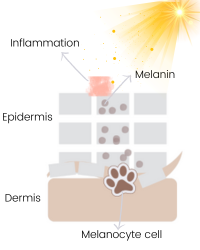
When the Sun’s UV rays hit our skin, skin gets inflammed, which activates melanocytes.
These melanocyte cells respond to this alert by producing melanin.
Melanin produced in melanocytes gets transferred to keratinocyte cells, the skin’s most abundant type of cell.
Keratinocyte cells are armed with melanin, which absorbs the Sun’s UV rays. Melanin in keratinocyte cells also generates a tan when exposed to the Sun for long periods. The colour of tan is from the colour of melanin.
The amount of melanin produced depends on our skin tone. People with darker skin tones produce more melanin, while those with fairer skin produce less.
The over-production of melanin in darker-skin-toned people produces hyperpigmentation.
In fairer skin tones, the skin may not produce enough melanin to provide adequate protection against the sun’s rays.
Less melanin means skin burns quickly. When skin burns, melanin-producing skin cells can get damaged (as the sun’s UV rays can easily penetrate and damage them). This results in a section of the skin losing its pigment and ending up with hypopigmentation. Hypopigmentation is when a particular skin area appears lighter in colour than the surrounding skin.
Here is a link to the section above: inflammation and pigmentation – Refer to this section to understand more about inflammation and pigmentation.
What does the pigmentation from the sun look like?
It often looks like small, darkened spots on the skin. Sometimes, it can be larger than a spot, like a patch.
Pigmentation from the sun’s rays is also called age spots, sun spots and lentigo.
Melanin provides a certain level of protection against the sun’s UV rays.
However, this protection is not completely foolproof; there is always a gap between the damage that UV rays can cause and the protection that melanin can offer.
This gap is significant enough to cause damage to the skin in the form of pigmentation and cell damage.
Regardless of how much melanin your skin can produce, it is important to use good sunscreen to protect our skin from the sun’s harmful rays.
There are 2 additional points I would like to mention:
Key points in this section:
The darker your skin tone, the more excess melanin you produce. Excess melanin does not mean more protection; it deposits itself in skin cells and results in hyperpigmentation.
The fairer you are, the less melanin you produce. Often, the melanin produced is not enough to provide the required protection against the sun’s UV rays, so you burn easily. This can result in hypopigmentation.
Hypopigmentation can occur in darker-skin-toned people, too.
In hyperperpigmentation, a section of skin is darker than the rest.
In hypoperpigmentation, a section of skin is paler than the rest.
Melanin is helpful but does not offer complete protection. Hence, sunscreen usage is a must.
Can All Causes of Pigmentation Be Fixed with Skin Care Products?
No.
Some causes of pigmentation, such as hereditary & skin conditions, medication and hormonal imbalance, can only be treated with prescription medication. So, you need to consult a doctor for these.
Two causes that can be addressed with non-prescription skincare products are trauma to the skin from breakouts & allergens and exposure to the sun’s UV rays.
It’s important to note that despite being just two of the five causes of pigmentation I listed in one of the earlier sections, these two can cause significant pigmentation on the skin almost daily, leading to dull-looking skin, marks, and scars. Additionally, the sun’s UV rays can lead to more severe problems in the future.
It is easier to prevent pigmentation from these two causes than to try to fix it once it appears. Off-the-shelf skin care products can almost completely prevent pigmentation. However, once pigmentation appears, skin care products can only work to some extent. We will need the help of skin treatments, like microneedling and laser therapy, to address pigmentation issues once they appear on our faces.
Uneven distribution of melanin
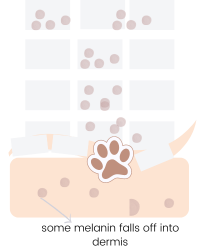
A big issue with pigmentation is that not all of it is on the top layer of the skin.
Melanocytes can get clumsy when they are in the middle of over-producing melanin. They are supposed to transfer melanin only to the top layer of skin cells. While doing that, they accidentally drop some, and these dropped ones end up in the deeper layers of skin. This is called dermal pigmentation.
But why is dermal pigmentation a problem? It’s deep in the skin; you can’t see it, so why bother?
We bother because though it is deep in the skin, it still affects the surface of the skin. It can stay deep but can still make the surface look dull.
Once it occurs, pigmentation is challenging to eliminate easily using off-the-shelf skin care products. If it is on the top layer of the skin, even if it is hard to get rid of, there is some hope. But if the pigmentation ends up in the deeper layers of skin, the dermis, then it is next to impossible to get rid of with skin care products. Only invasive procedures like needling can have some effect. These procedures can only be administered by a professional.
Prevention is much simpler when it comes to pigmentation. Once it occurs, there are no guarantees.
Categories of Skin Care Ingredients for Pigmentation
Skincare ingredients that can help with pigmentation can be classified into 4 categories.
Before I get into these categories, here is a quick reminder: We are not trying to reduce melanin production with skincare products. We are trying to stop the over-production of melanin. More melanin does not mean extra protection. Melanin can only provide a certain level of protection. Once that level is reached, even if more melanin is produced, it can’t help. This extra melanin becomes a waste and leads to hyperpigmentation.
Skin Care Ingredients that Help Fight Pigmentation
Alpha arbutin
Tyrosinase inhibitor
This ingredient interferes with the activity of the enzyme tyrosinase. It binds to the enzyme and inhibits its activity.
It works slowly – which is good because the slow action reduces only the excess melanin production, not complete melanin production.
Alpha arbutin works by slowly releasing a compound called hydroquinone. Most dermatologists prescribe hydroquinone as a skin care medication. However, hydroquinone can depigment your skin at higher percentages, destroying all melanin. This is not good because the skin loses its colour and its first layer of protection from environmental irritants.
Alpha arbutin is much safer as it releases hydroquinone slowly. Alpha arbutin is also called natural hydroquinone.
Alpha arbutin is effective from 0.5% to 2% and is most effective at 2%.
There is another form of arbutin called beta arbutin, which is not as effective as alpha arbutin.
Ascorbic acid (Vitamin C)
Tyrosinase inhibitor, Antioxidant
Vitamin C has a dual benefit regarding pigmentation. It has both tyrosinase-inhibiting and antioxidant properties.
Let me explain…
Regarding pigmentation, its primary benefit is as a tyrosinase inhibitor. Tyrosinase enzyme requires copper ions to help produce melanin. Vitamin C absorbs copper ions. Thus, it interferes with the activity of tyrosinase and reduces melanin production.
It also works as an antioxidant. Environmental irritants like pollution and the Sun’s UV rays, when they hit our skin, form something called free radicals.
These free radicals inflame the skin and stimulate melanocyte cells to produce melanin. The darker your skin tone, the more melanin these cells produce; some of this additional melanin is excess, which leads to pigmentation. These cells will continue producing excess melanin as long as there is inflammation.
Vitamin C can reduce the inflammation by attacking the free radicals. They can neutralise the harmful effects of free radicals. Once free radicals are neutralised, inflammation decreases, and melanin production stops.
Unfortunately, the pure form of Vitamin C, ascorbic acid, is difficult to formulate in skin care products. It is highly unstable. A well-formulated product, ascorbic acid, is usually expensive, so many skincare manufacturers use Vitamin C derivatives.
While all Vitamin C derivatives are antioxidants, most do not have the tyrosinase-inhibiting property near the extent found in ascorbic acid. Their antioxidant property is also not at the same level as ascorbic acid’s.
However, a couple of derivatives are almost as effective as ascorbic acid.
Here is a list of derivatives:
Tetrahexyldecyl Ascorbate
Tetra-isopalmitoyl ascorbic acid
3-O-ethyl-l-ascorbic acid
Sodium Ascorbyl Phosphate (SAP)
Ascorbyl Glucoside
Magnesium Ascorbyl Phosphate (MAP) – not that effective but suitable for sensitive skin
Vitamin C is effective from 10% to 20%. The closer it is to 20%, the more effective it is. However, after about 15%, it can irritate the skin. So, if you have sensitive skin, it is better to use it at lower concentrations.
Licorice Root Extract ( Glycyrrhiza Glabra)
Tyrosinase inhibitor, Anti-inflammation
This ingredient offers a 2-way benefit.
The 2 ingredients in licorice root extract that are beneficial to the skin are glabridin and liquiritin.
These two ingredients fight pigmentation in 2 different ways.
Glabridin inhibits the activity of tyrosinase, which means that tyrosinase is less effective in melanin production. This reduces excess melanin production.
The ingredient, liquiritin, helps to disperse melanin.
When melanocyte cells transfer the melanin packages to keratinocyte cells, they sometimes don’t do it uniformly, so some keratinocyte cells have more melanin than the rest. This means these cells end up with a concentrated amount of melanin, and the skin around those cells will pigment with a dark colour.
The ingredient liquiritin disperses the concentrated melanin. Dispersion means melanin is spread out more evenly rather than accumulating in a few spots, reducing hyperpigmentation.
Licorice Root Extract also has anti-inflammatory properties. It can reduce inflammation. If inflammation goes down, the over-production of melanin goes down. Less excess melanin means either no pigmentation or a significant reduction in pigmentation.
Licorice Root Extract is effective at around 10%.
Kojic acid
Tyrosinase inhibitor, Antioxidant
The enzyme tyrosinase requires copper to help it produce melanin. Kojic acid absorbs the copper and thus inhibits the activity of tyrosinase. This reduces the overproduction of melanin, which in turn reduces hyperpigmentation.
Kojic acid also has antioxidant properties. It neutralises free radicals, nasty substances that cause inflammation on the skin. Inflammation leads to hyperpigmentation, especially in darker-skin-toned people. Helping neutralise free radicals reduces the chances of hyperpigmentation.
Kojic acid is effective between concentrations of 1 and 4%.
Azelaic acid
Tyrosinase inhibitor, Anti-inflammation
Azelaic acid also inhibits the activity of the tyrosinase enzyme.
Azelaic acid has to be at high concentrations, between 15 and 20%, to work for pigmentation. At this concentration, in some countries, it can only be bought with a prescription.
Studies show that 20% azelaic acid is as effective as 4% hydroquinone in treating hyperpigmentation without hydroquinone’s side effects. Hydroquinone is considered the gold standard in treating hyperpigmentation.
This ingredient also has anti-inflammatory properties.
This good ingredient targets pigmentation by calming skin and reducing melanin production.
Hydroquinone
Works in multiple ways to reduce pigmentation
A doctor’s prescription is needed to buy hydroquinone. However, it has many side effects, and people often misuse it.
Hydroquinone is considered the gold standard in treating hyperpigmentation, but use it wisely and only under a doctor’s guidance!
Unfortunately, some people find ways to buy it without a prescription and use it more than they should. Please avoid doing that!
Tretinoin
Tyrosinase inhibitor, Cell renewal
Tretinoin, also known as retinoic acid, is a medication that requires a prescription in some countries.
Unlike hydroquinone, tretinoin does not have the same side effects. However, it is still potent and potentially irritates the skin.
Gradually increasing its concentration can help minimize this. However, tretinoin poses no significant health concerns compared to hydroquinone.
Tretinoin inhibits the activity of the tyrosinase enzyme. By interfering with its function, tretinoin reduces the excess melanin tyrosinase can help produce.
Tretinoin also helps fight pigmentation by increasing the cell renewal process.
Let me explain how this helps pigmentation…
Cells in the top layer of the skin must fall off regularly to make way for newer cells from the deeper layers.
But sometimes, especially with age (and ageing starts in the early twenties 🙂 ), the rate of new cell formation in the deeper layers decreases. And so the old cells are forced to stay in the top layer.
When skin is pigmented, these old cells contain a significant amount of melanin. If these old cells are stuck at the top, the skin stays pigmentated because of their melanin.
This is where tretinoin comes in. Tretinoin speeds up the process of new cell formation in the deeper layers of skin.
With more new cells, the old cells fall off, resulting in less/fading pigmentation.
Tretinoin can be used up to 0.1%. But it is important to start at much lower concentrations…from, say, 0.025% or 0.05%, and gradually get to 0.1%.
Retinol
Tyrosinase inhibitor, Cell renewal
Since tretinoin needs a prescription, you can use off-the-shelf retinol products if you can’t get a prescription.
These work the same way as tretinoin but are less effective in treating pigmentation.
Tranexamic acid
Anti-inflammation
Tranexamic acid has a specific anti-inflammatory property. Its anti-inflammation is targeted and effective in reducing inflammation so that melanocyte cells don’t overproduce melanin.
Once the overproduction of melanin stops, hyperpigmentation also stops.
It must be between 2 and 5% effective in skin care products.
Niacinamide
Anti-inflammation, Inhibits melanin distribution
Niacinamide reduces inflammation in the skin. When inflammation is reduced, the overproduction of melanin stops. No excess melanin means no hyperpigmentation.
Melanin is produced in melanocytes and then transferred to keratinocytes, the skin’s most abundant cell type.
The pigmentation is mostly due to excess melanin in these keratinocyte cells.
Nicianamide reduces the transfer of melanin from melanocytes to keratinocytes. By reducing this transfer, niacinamide helps prevent pigmentation from occurring.
A concentration of up to 5% is effective.
Tips on How to Use the Pigmentation SkinCare
Additional Treatments for Pigmentation
These treatments should only be done by a professional. These are not home care treatments.
Hereditary, Skin conditions, Hormonal imbalance & Medication
Pigmentation caused by hereditary conditions, certain skin conditions, hormonal imbalances, and medication needs medical attention. Prescription medicine is necessary to treat it.
The treatment options for these conditions are beyond the scope of this website.
To give you an idea, we’ll briefly discuss the types of pigmentation caused by these conditions below:
Hypopigmentation (section(s) of skin lighter than the rest):
Hyperpigmentation (section(s) of skin darker than the rest):
Pigmentation, both hypo and hyper, could also be the side effect of certain types of medication.

